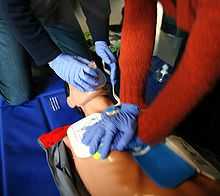Instructional design/Learning objectives/Authentic Learning Objectives
< Instructional design < Learning objectives| Instructional Design | ID Learning Objectives | < Back | Next > |
Authentic Learning Objective Components
When incorporating authentic activities in instructional strategies, the learning objectives need to reflect real-world scenarios. The components of authentic learning objectives are:
- Elaborated Condition - describe the conditions in detail
- Authentic Action - require performances that would simulate real-world contexts
- Authentic Standard of Performance - use criterion that assess an authentic activity.
Authentic Learning Objective Example
Non-authentic: Given a customer scenario, the employee will be able to list the banking products that meet the needs of the customer.
Authentic: Given a customer scenario in which a customer describes his or her needs, the learner will be able to select a bank account structure for the customer. The learner's choices must be accurate, complete, and consistent with the bank's mission statement, compliance policies, and U.S. laws, as well as match the choices of an expert in nine out of ten cases.
Learning Objective Example - CPR Scenario

Now let's return to our CPR scenario example from the previous page. How do you think we can make that learning experience more authentic. How can we create authentic learning objectives?
Non-authentic:
- Given a scenario where a customer is choking, the participant must be able to list the symptoms of choking victim with 100% accuracy. (Knowledge)
- During a simulation, the participant must be able to explain how to check the customer's airway with 100% accuracy. (Comprehension)
Authentic:
- Given a role-play scenario where one of the participants acts as a choking customer, the learner will be able to assess the situation, check the customer's breathing, and perform the Heimlich manuever (if required). The learner must accomplish the procedure with a 100% score on a choking assessment worksheet. (Knowledge, Comprehension, Application, and Analysis)
References
Honebein, P.C. (2006) Authentic Activities for E-learning and Beyond. Reno, Nevada: Honebein Associates, Inc.
Navigation
Click Next to continue
| Instructional Design | ID Learning Objectives | < Back | Next > |